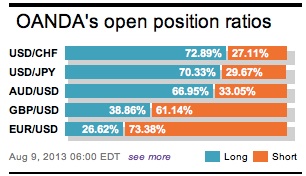A silent market can be the most deadly and this past week is no exception. Half-hearted interest from the remaining members on the street has seen the ‘mighty’ dollar ending this week against most of the major currencies under pressure. Apathy is dangerous, it tends to lead to a false sense of security and all of a sudden, with liquidity at a premium, investors are paying away hard earned profits in a market were prices are squeezed for ‘little’ reason – mostly positional. This is only week one of the Euro shutdown due to the annual holiday season, and already due to market boredom, week two could be equally insufferable.
Next week, with far less interesting data points on offer, the markets roadmap may be rather similar. Investors clearly have to address positional pain before the interesting events truly begin in September – German and Aussie elections, the highly anticipated FOMC meet where tapering will or will not be introduced. Until then, it’s all about keeping ones powder dry, waiting for depth to return to the marketplace.

What is good for China seems to be good for AUD. More upbeat economic data has raised market expectations of stability in Asia’s largest economy. China’s CPI rose +2.7% on the year in July, slightly lower than market expectations of +2.8%. Inflation was steady in June, and well below the government’s target of +3.5%. Industrial production for July grew +9.7%, beating a market expectation of a +9% print. Both of these data points can be added to investor’s positive sentiment.
What is most interesting for Australia is that China commodities imports rise strongly last month. The first tranche of detailed trade data for July showed a strong advance in imports of key raw materials, suggesting that the usual summer seasonal lull in materials-intensive activity may be “shallower than initially expected.” Crude oil imports broke out of their year-to-date range, climbing +16.7% m/m to 26.8m tonnes. Iron ore imports bounced back in the month to 74.1m tonnes, a gain of +9.8% m/m and copper imports advanced +1.9% m/m to 430,000 tonnes. Today’s data combined with yesterday’s better than expected trade data gives investors more reason to believe in economic stability from the world’s second largest economy.

It’s all music to the AUD ears. After hitting a three-year low earlier this week on the back of the latest RBA rate cut ($0.8848), the currency has managed to pull itself up by the bootstraps and appreciate three whole cents. The currency’s gains however have been somewhat limited after the Reserve Bank of Australia lowered its expectations for economic growth, and after policy makers were somewhat vague on the outlook for interest rates (+2.25%). A bias on indications that the central bank is close to calling an end to interest rate cuts has the AUD on firmer footing as we end the week. The RBA is expected to stand ‘pat’ as policy makers wait and see what happens to the AUD. If the said currency continues to weaken, coupled with broad changes to the Aussie economy, then most likely there will be no need to cut rates any further. However, if inflation remains low then the RBA has room to ease rates much further.

Political grandstanding will become more obvious for both Germany (election: September 22nd) and Australia (election: September 7th) over the coming weeks. Germany’s Chancellor Merkel and her ruling center-right coalition will certainly become more vocal about Europe’s largest economy, describing how strong a Euro backbone it has become. The country’s economic minister reported this morning that the German economy picked up steam in the second quarter this year on the back of private consumption and construction. Germany will get to release its GDP data mid-week next week. Analysts are looking for economic growth to grow +0.5% on the quarter. Stronger data may signal that the Euro-zone as a whole, may have escaped from the ‘clutches of recession,’ especially after six consecutive quarters of contraction.

With many of the major currencies trading at elevated levels against the dollar, gains for the EUR have been somewhat limited. Most investors have been trying to put a cap on the 17-member single currency. A bumper week of economic data for Germany, coupled with a confirmation of its AAA rating this week has boosted hopes that Europe’s solid “backbone” is again gaining some economic traction. The scope for the EUR remains on the upside for a retest of the 30-day upper Bollinger band just above 1.3430. Despite liquidity remaining a premium, the currency’s daily momentum remains positive, adding to its overall upside potential.

Other Links:
Mighty Dollar Deflates During Europe’s Timeout
Dean Popplewell, Director of Currency Analysis and Research @ OANDA MarketPulseFX
This article is for general information purposes only. It is not investment advice or a solution to buy or sell securities. Opinions are the authors; not necessarily that of OANDA Corporation or any of its affiliates, subsidiaries, officers or directors. Leveraged trading is high risk and not suitable for all. You could lose all of your deposited funds.


